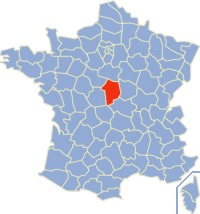Communes of the Cher department facts for kids
This article is about the different towns and villages, called communes, in the Cher department in France. A department is like a county or a region in other countries. The Cher department has 290 of these communes!
Each commune is a local area with its own mayor and local government. They are the smallest divisions of France that have their own elected council. Think of them as individual towns or villages, each with its own unique character and history.
Some of these communes are part of a special group called a Communauté d'agglomération. For example, the one around Bourges was created in 2003. This means they work together on things like public transport or waste management, which helps them share resources and improve services for everyone living there.
What is a Commune?
A commune is the smallest type of administrative area in France. It's like a local town or village that has its own local government. Each commune has a mayor and a town council who make decisions for the people living there.
How Communes are Organized
Every commune in France has a special number called an INSEE code. This code is like a unique ID for each town or village. It helps keep track of all the different places in France. You might also see a Postal code for each commune, which is used for sending mail.
The Cher department has many different communes, from big cities like Bourges to smaller, quieter villages. Each one plays an important part in the life of the department.
List of Communes in Cher
The Cher department has a total of 290 communes! Listing all of them here would make this article very long. However, you can imagine a big list that includes every town and village, along with its unique INSEE code and postal code. Some of these communes are:
- Bourges (which is the main city of the department)
- Vierzon
- Saint-Amand-Montrond
- Sancerre (famous for its wine!)
- Aubigny-sur-Nère
Many of these communes are small, peaceful places, while others are larger towns with more people and activities. They all contribute to the rich history and culture of the Cher department.
See also
 In Spanish: Anexo:Comunas de Cher para niños
In Spanish: Anexo:Comunas de Cher para niños


